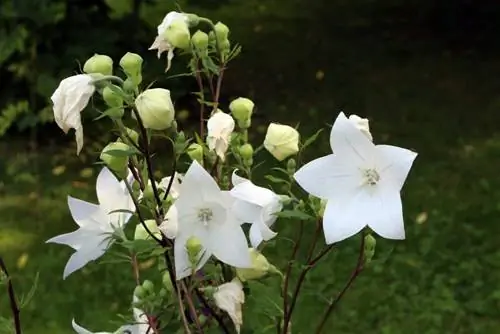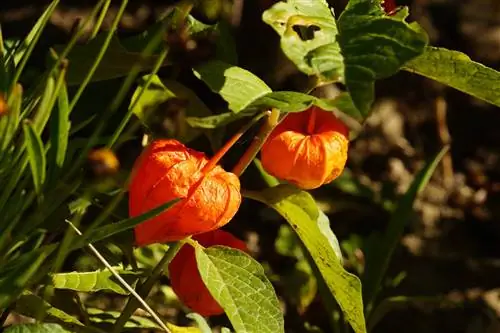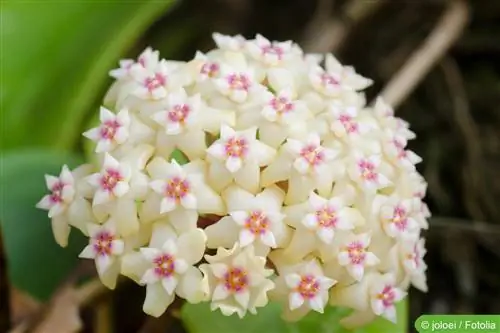- Author admin [email protected].
- Public 2023-12-17 03:39.
- Last modified 2025-06-01 06:48.
The gunner flower is an easy-care plant with a velvety leaf structure that gets its name from its ability to shoot out pollen like a cannon. But older plants tend to shed easily and become unsightly over time. However, if the gunner flower is propagated in time, it can form new offshoots and shine in its usual splendor.
Location
The gunner flower, also known by the Latin name Pilea, belongs to the nettle family and prefers a partially shaded, warm and bright location. If it is placed in a place that is too dark, it will lose its beautiful leaf color and grain. Gunner flowers love fresh air and room temperatures of 18 to 20 °C in summer and 13 to 16 °C in winter, but drafts should generally be avoided.
While the attractive plant can be placed further away from the window in the warm season, it can be exposed to direct sunlight in the winter. The cannon flower can also be used as a decorative accessory to brighten up the balcony or terrace in spring, but it should only be placed outdoors after the Ice Saints from mid-May.
Care
Pileas like high humidity, so small water evaporators can be used to create the desired climate. It is also recommended to place the pot on a bowl filled with water and gravel. On the other hand, she doesn't appreciate being sprayed with water at all.
Pouring
For gunner flowers, the substrate is only slightly moistened and not watered because soil that is too wet leads to root rot and leaf shedding. For this reason, the pot ball should be about 2/3 dry before any further watering. In the cold season it is recommended to water them a little less.
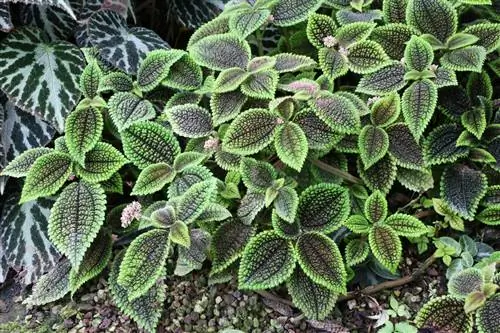
Fertilize cannon flower - nutrient requirements
The Pilea is fertilized between April and October max. every two weeks with a commercially available liquid fertilizer that is added to the irrigation water. If the substrate consists of peat soil, a stronger fertilizer solution can also be used.
Substrate and soil
Cannon flowers are cultivated from a mixture consisting of equal parts compost soil and peat. Alternatively, soil made from pure peat can also be used. However, since the peat soil is very poor in nutrients, the plant should definitely be fertilized in this case.
Repotting the Gunner Flower
The most ideal time to repot the plant is spring. The Pilea does not form a pronounced root system and grows best in shallow bowls or half-height, wide pots.
Propagate the Gunner Flower
Even if the gunner flower is absolutely undemanding, it loses its shape after just two to three years and can be replaced by self-grown shoots. The most ideal time for propagation is early spring, especially the months of April to May. To do this, a cutting of around 7 cm long is cut from the mother plant directly below its leaf node. The leaves are then removed and the cutting is placed in soil consisting of equal parts sand and peat. After a plastic bag has been placed over the planter, the cutting can be placed in a bright but not sunny location.
The substrate should now only be watered moderately until roots have formed because the growing soil should always only be kept slightly moist. If the small cutting has sufficient roots, it can then be repotted into a larger planter together with other specimens, which should not exceed 10. So that the young gunner flowers have the opportunity to branch well, the shoot tips should be shortened at regular intervals.
Special features of the gunner flower
- Main shoots of the Pilea usually branch laterally
- for this reason bushy growth
- To ensure that the growth pattern is preserved, excessively long shoots are removed
Even if the Pilea can withstand a lot, care must be taken when watering that the leaves do not get wet, otherwise black spots can quickly form. It also loses its leaves if it is too dark or too dry.
Pests of the plant are:
Spider mites
If the gunner flower is infested with spider mites, the leaf color appears dull. Furthermore, webs can be seen under the leaves, which can only be combated by keeping the plant moist.
mealybugs
When mealybugs are infested, a sticky leaf coating appears. The white, wingless pests then sit on the stems and can be controlled either by stripping them or with white oil.
Diseases of the Gunner Flower
- If the leaves of the plant begin to fall off and change color, the cause is waterlogging. Then at the latest you should water less.
- If there are brown spots with a mouse-gray coating under the leaves, this is gray mold, which will be eliminated by removing the leaves.
- If there is a lack of water, the gunner flower reacts with wilting and limp leaves, which can be prevented by regular watering.
Using the Gunner Flower
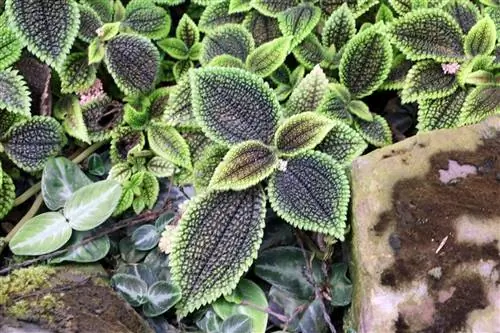
Cannonier plants form a wonderful contrast to other plants with their velvety and sometimes beautifully structured leaves. This makes them particularly ideal for hanging baskets, shallow bowls and pots. The Pilea also forms a fascinating ensemble in pots or plant bowls together with other plants.
What you should know about the gunner flower in brief
The undemanding plant is ideal for indoor and outdoor use depending on the season and requires little care. Once its short lifespan of around two to three years is over, it can easily be propagated with new shoots. With regular care, the attractive gunner flower will always present its full splendor.
Pilea cadierei
- In the wild, the gunner flower grows in all tropical areas except Australia.
- It belongs to the plant family of the nettle family. As a houseplant, the gunner flower grows to a height of 20 to 25 centimeters.
- The gunner flower prefers a bright and airy location, but does not tolerate direct sunlight.
- So that the gunner flower can thrive, it must not be watered too much. They should be watered moderately and watered even less in winter.
- Cannon flowers prefer high humidity, small water evaporators favor the desired climate.
- The gunner flower Pilea cadierei has very beautiful dark green leaves with white veins. If the grain recedes, this is a sign that the plant is too dark.
- The ideal room temperature is 13 to 16 degrees Celsius in winter and 18 to 20 degrees Celsius in summer.
You should propagate the gunner flower in good time, as it loses its shape and thus its beauty with age. To do this, individual plant parts are cut off and placed in a container with water. The cuttings form roots very quickly. Pests and diseases occur very rarely in the cannon flower. In spring it can be repotted and cut back as it then grows bushier.
Pilea peperomoioides
- The Pilea peperomioides originally comes from China. In nature, this gunner flower can also be found almost everywhere, except in Australia. This species is also cultivated as a houseplant because of its beautiful leaves.
- It prefers a partially shaded location, which also helps its leaves grow larger.
- The room temperature should be a constant 20 degrees Celsius. The plant is watered regularly and is only watered again when the soil has dried out slightly.
- From March to October, the Pilea peperomioides should be fertilized every two weeks with ordinary flower fertilizer.
- You can propagate them using shoot tip cuttings, which you simply cut off and place in water until they have formed roots.
- The long shoots of the gunner flower can also be cut back in spring so that it grows back fuller.



